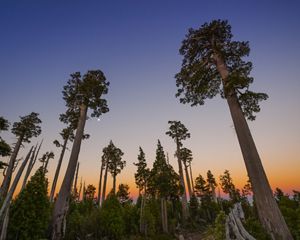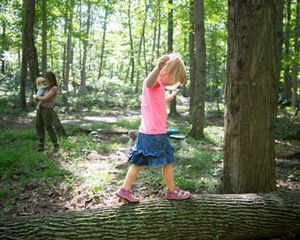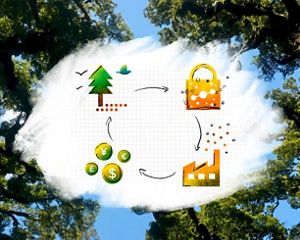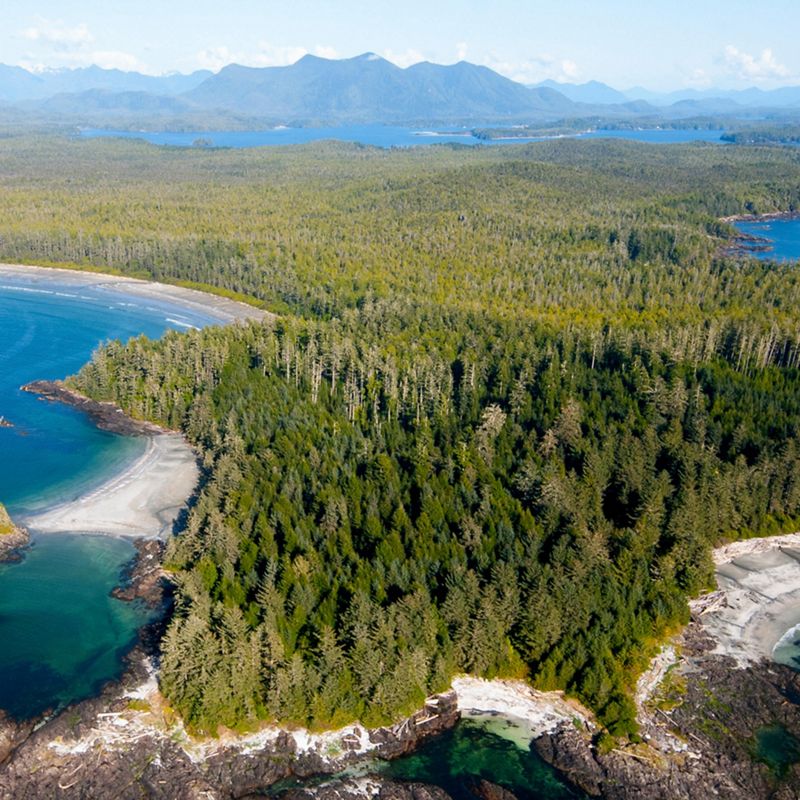
How North America’s Emerald Edge Could Help Change the World
Indigenous Peoples are leading conservation and climate action in this critical rainforest.
This story is part of our Living Carbon series, covering the power of natural climate solutions for communities, biodiversity and the planet. Explore the Living Carbon stories.
With its iconic wildlife from wolves to whales, spirit bears to salmon, its towering trees and glittering waters, the Emerald Edge stretches from Oregon, through Washington state and British Columbia, and up into Southeast Alaska. It is the world’s largest coastal temperate rainforest and a biodiversity haven—spanning over 100 million acres of lush forest, thousands of rivers and mountain streams, 40,000 islands and 35,000 miles of coastline.
For millennia, this awe-inspiring region has been home to Indigenous Peoples, including First Nations, Alaska Natives and Coastal Tribes. Their cultures, languages, stories and livelihoods are directly connected and interwoven with the land and seascape. Indigenous Peoples are the original and remain the most important stewards of the Emerald Edge, both now and for generations to come.
The Emerald Edge is also a global carbon storage powerhouse. Today, the need to rapidly reduce and eliminate global greenhouse gas (GHG) emissions from the energy and transportation sectors and beyond could not be more urgent—and maximizing nature’s ability to store and pull carbon dioxide from the atmosphere is a critical and complementary solution to addressing the climate crisis at the scale it demands.
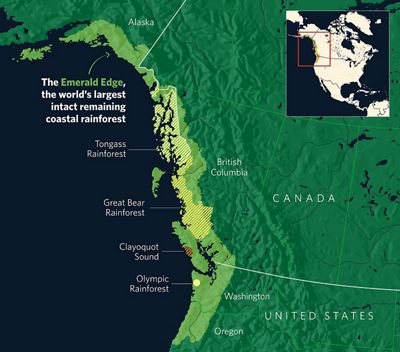
The vast old-growth forests of the Emerald Edge are one of the world’s best examples of natural climate solutions, storing as much as 300 million metric tons of carbon a year—equivalent to the annual energy use of nearly 58 million homes. That’s more than the population of all of Canada, plus Washington state, Oregon and Alaska combined. And protecting forests for their carbon-storage capabilities does more than provide one more tool for addressing the climate crisis: It also creates more resilient, biodiverse ecosystems and vibrant and healthy human communities.
“We can actually get a big bang for our buck by addressing climate solutions that also address the nature crisis,” says Tom Cors, Director of North America policy and government relations at The Nature Conservancy (TNC). “Natural climate solutions are not a substitute for decarbonizing our economy and energy sector. But they are a complement, so that we can hit more emissions reductions than we could otherwise.”
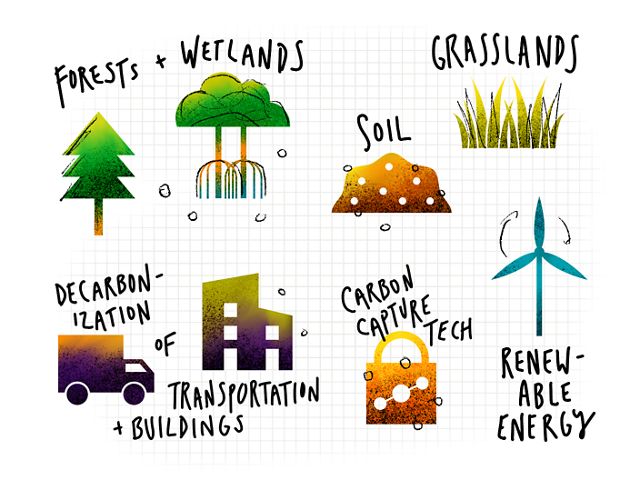
What are carbon offsets?
Carbon offsetting entails reducing or removing greenhouse gas emissions in one place to compensate for emissions elsewhere. Through carbon markets, carbon offset projects can sell or trade a carbon credit for each metric ton of carbon dioxide (or equivalent) to emitters to help accelerate overall carbon reduction goals.
> Check out Carbon Offsets, Illustrated.
The many tools available to reduce emissions include public policy, corporate action, market transitions toward renewable energy and transforming transportation, among others. As Cors adds, these efforts must complement the swift and immediate reduction of GHG emissions worldwide. In addition, the emerging tools of carbon offsets and markets, when implemented to high standards, can ensure that the carbon in forests like those in the Emerald Edge is protected and can bring much-needed revenue to local communities and conservation efforts.
As the science behind carbon offsets evolves, critiques of this strategy to support carbon sequestration are vital—particularly in determining “additionality” (meaning the emissions reductions would not have occurred in the absence of a market for offset credits). Indeed, valid critiques of carbon markets, offsets and their additionality have already improved TNC’s understanding of the relationship between forest carbon and forest management and how to create high-standard forest carbon projects that are truly additional, are centered in community priorities and bring benefits to the people of the Emerald Edge.
Indigenous Lands
Lands stewarded by Indigenous Peoples hold 17% of the world’s remaining forest carbon and 80% of its biodiversity.
In addition to exploring carbon offsets, TNC uses private philanthropy and public spending to finance nature-based carbon sequestration and climate resilience projects in the Emerald Edge. And TNC and community partners are co-developing other non-carbon-offset pathways, such as sustainable economic development, eco-tourism and clean energy projects, to scale, sequester or reduce carbon pollution across the region while centering community priorities.
Natural Climate Solutions in the Emerald Edge
Today, as the climate crisis demands urgent action, Indigenous Peoples are asserting their rights and authority over their lands and waters in support of greater protections and stewardship of the natural environment. At this pivotal moment, the Emerald Edge presents an unparalleled opportunity to learn from and support the conservation leadership of Indigenous Peoples and local communities to help solve the world’s biggest challenges.
Through a community conservation approach that respects Indigenous rights and strengthens Indigenous authority, TNC and partners are working to answer the global challenge to scale up natural climate solutions (NCS) that could contribute one-third of the emissions reductions needed to reach global climate goals by 2030 (11 gigatons CO2 equivalent)—and ensure that these solutions and projects are grounded in community priorities to help guarantee that they will be stewarded for generations to come.
“In the Emerald Edge, natural climate solutions mean protecting and restoring forests and other carbon-rich ecosystems through activities that avoid greenhouse-gas emissions and enhance the storage of carbon in both old- and new-growth trees,” explains Eric Delvin, Director of TNC's Emerald Edge Program. “There are few places on the planet that have as much potential to protect carbon and support Indigenous and community priorities as the temperate rainforests of the Emerald Edge.”
Quote: Eric Delvin
There are few places on the planet that have as much potential to protect carbon and support Indigenous and community priorities as the temperate rainforests of the Emerald Edge.


One key approach Delvin underscores is keeping old-growth forests standing. When old-growth trees are cut down, the carbon held in these centuries-old trees is effectively irrecoverable—needing centuries to grow and sequester as much carbon as was lost. With urgent action needed on the climate crisis, keeping carbon in old-growth trees is one of many ways to slow down and reverse global trends. And an important way to ensure this happens is to increase the economic value of keeping forests standing in the Emerald Edge, including through carbon offsets.
Delvin explains that, in this region, forests are buffered from major disturbances like the fires and drought occurring in other parts of North America. And the forest and carbon programs are well-regulated through robust state and provincial rules, meaning TNC and partners can have confidence that the carbon will stay in the trees and that, when carbon offset projects are put in place, their impact is real and will provide that additional benefit to the climate, ecosystems and communities.

“The power of natural climate solutions—and carbon offset markets specifically—in the context of Indigenous land conservation is that it's one of the few tools available to communities that allow them to make the decisions that they want in seeking their conservation goals,” says Delvin. “We have incredible partnerships with Indigenous communities to achieve a win-win in terms of supporting existing histories and values and protecting carbon in the forest.”
It is important to remember that Indigenous Peoples have stewarded these forests for millennia, well before the trees’ carbon sequestration was recognized as a cost-effective climate solution. And Indigenous Peoples have living cultures and livelihoods connected to these lands today. TNC and its Canadian affiliate Nature United have worked alongside Indigenous Peoples and communities across the Emerald Edge for the past two decades to safeguard the region’s rich biodiversity and build sustainable, resilient nature-based economies.
Emerald Edge in British Columbia: A Rich Recent History of Indigenous-Led Action
The Great Bear Rainforest
Amidst decades of conflict and devastating corporate-driven deforestation in British Columbia, two areas of the Emerald Edge in this Canadian province are now serving as a shining example of Indigenous-led conservation and climate action, ranging from ground-breaking forest carbon projects to a total ban on grizzly bear hunting.
A key turning point came in 2009, in the Great Bear Rainforest region along the west coast of British Columbia, when an alliance of coastal First Nations and the provincial government launched one of the largest carbon offset projects in the world, and the first Indigenous-led carbon project in North America. This was later strengthened with the signing of Atmospheric Benefit Sharing Agreements that give First Nations the ownership and right to sell carbon offsets in local and international carbon markets. Today, the Great Bear Forest Carbon Project sequesters 1 million tons of CO2e per year, and the sale of carbon credits is helping First Nations protect the forest from industrial logging, support their ecological and cultural values, and build economic self-sufficiency.

Our global insights, straight to your inbox
Get our latest research, insights and solutions to today’s sustainability challenges.
Sign Up“Carbon offsets are giving First Nations in the Great Bear Rainforest the opportunity to forgo extractive activities that don't align with their values,” says Nature United’s British Columbia Program Director Mike Reid. “The carbon revenue is creating livelihoods and advancing priorities, such as stewardship efforts and natural resource management, defined by the communities themselves,” Reid says. “And it’s creating a model for other Indigenous-led carbon projects.”
In 2016, the Great Bear Rainforest Agreements pledged to conserve 19 million acres of land that is home to many First Nations, including making 9 million acres completely off limits to logging. This is one of a series of joint commitments between the provincial government and First Nations that began in 2006. One of the earliest direct outcomes of these Agreements was the creation of Coast Funds, combining an endowment fund that supports Indigenous-led conservation and an economic fund that supports Indigenous-led economic activities compatible with conserving the Great Bear Rainforest and the Haida Gwaii archipelago.
Since 2008, Coast Funds and First Nations have attracted $370 million in new investments for local resource management and sustainable economic development. This has resulted in over a thousand permanent new jobs in First Nation communities, 80 protected areas conserved through direct action by First Nations, and 4.2 million acres monitored by members of the Indigenous Guardians program—who are the eyes and ears of the forest, deterring illegal activities and participating in advanced research grounded in Indigenous knowledge. TNC raised $39 million for the conservation endowment fund, and Nature United is now supporting shifts to further strengthen First Nation leadership in Coast Funds in the future.

Clayoquot Sound
Change is also afoot just to the south of Great Bear, in Clayoquot Sound on the west coast of British Columbia’s Vancouver Island, where First Nations are charting a new future for hundreds of thousands of acres of old-growth forests. But it’s been a long, arduous process to get to this point.
Nearly 30 years have passed since the 1993 War in the Woods culminated in the arrests of more than 900 people trying to prevent old-growth logging in Clayoquot Sound, including many First Nation Elders and youth. It was the largest mass arrest in Canadian history, and it shone a harsh global spotlight on the deforestation crisis. The conflict pitted communities against each other and villainized those whose economic livelihood often depends on the land. Yet it would take another generation to turn things around, a period during which old-growth logging and the mass export of unprocessed logs were ramped up even more, endangering both the forest ecosystem and the livelihoods and cultural values of First Nation communities.
Now these communities are successfully reasserting their rights and identifying new opportunities to advance their own priorities, with the overarching goal to protect old growth while supporting sustainable economic development. Nature United has supported this Indigenous-led transformation by providing scientific research, technical support, and funding resources.
The first big milestone came in late 2020, when the provincial government of British Columbia implemented a deferral of old-growth logging in much of the region and engaged the First Nations in dialogue about land-use visioning to move the region from commercial forestry to protection and sustainable management, a major victory for the First Nations. The Nations and the B.C. governments are now working together to create permanent protected areas, negotiate community forest tenures and establish a co-management arrangement.
Now, inspired by their neighbors in Great Bear to the north, First Nations in Clayoquot Sound are investigating the potential for their own forest carbon project to provide a revenue stream to steward their territories and realize their vision for the land.

Emerald Edge in Washington State: Learning in Real Time from a New Forest Carbon Project
The state of Washington in the United States has also suffered more than a century of industrial forest management and rapid deforestation. Years of heavy logging on the Washington coast’s Olympic Peninsula have reduced the forest’s ability to store carbon and made it less biologically diverse and less resilient to drought. The increasingly frequent hot, dry spells brought by a changing climate threaten salmon—which need cool, clear streams to survive—and impact communities that depend on healthy fisheries for their livelihoods.
But the Olympic Rainforest’s future is promising, thanks to efforts led by local communities, in partnership with TNC. Since 2010, TNC has worked with Tribal nations, private landowners and public groups to buy cutover timberlands along the Hoh and Clearwater rivers and restore these lands. And TNC’s work 130 miles to the south, in the Ellsworth Creek Preserve, is demonstrating methods to restore industrial timberlands to mimic old-growth forest systems, restore the forest’s ability to protect salmon and store carbon, and improve its resilience in the face of drought.
Building on this experience and lessons learned, in 2020 TNC launched its first forest carbon project on TNC-stewarded lands in the Emerald Edge—the latest living laboratory for the organization to learn about the dynamics between carbon sequestration and carbon offsets, and how they can financially support improved forest management.

The Washington Rainforest Renewal Project (WRRP) is being implemented in 22,000 acres of forest extending across three major watersheds: the Hoh River, Queets/Clearwater Rivers, and Ellsworth Creek. Through these projects, TNC is learning how to restore forests and wildlife habitat while understanding how forests can store more carbon for longer.
The project is generating about 43,000 metric tons of carbon offsets every year and is projected to offset more than 2.9 million credits over 20 years. This includes 2.1 million credits directed solely toward removing carbon from the atmosphere, all verified by the American Carbon Registry. With rising demand steadily driving up the price for carbon credits, WRRP is generating an important new revenue stream to invest in sustainable forest management, improved wildlife habitat and thriving local communities.
"In addition to quickly reducing emissions across the board, maximizing carbon sequestration is one of many other ways we can support climate action," says James Schroeder, conservation Director at TNC’s Washington chapter.
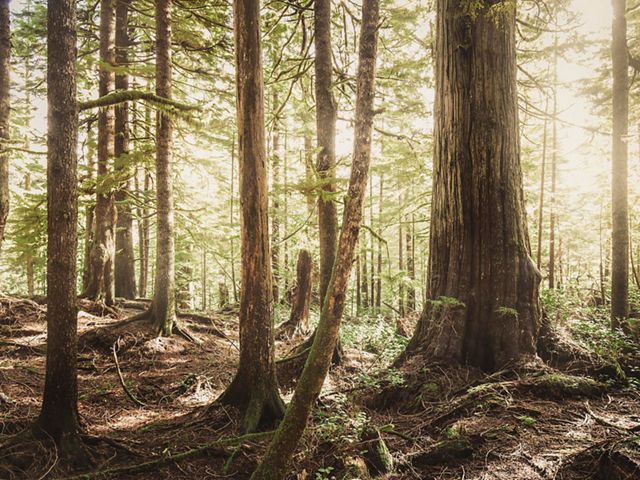
“Carbon offsets are just one tool for sequestration,” adds Schroeder. “And when it comes to offsets and carbon markets, there's a lot for us to learn. This WRRP pilot program is helping us do that. We’re learning how to improve the science and calculations of offsets, how to navigate the new and emerging carbon markets and better define what high-quality offsets look like, how communities can benefit from carbon funds, how funds can support better forest management, and how it all fits within a bigger picture of climate action. We're learning a lot as we go, which is both a humbling and an exciting process.”
Beyond carbon storage, the WRRP has downstream benefits for the health, well-being and prosperity of coastal Tribes and other local communities through increased salmon productivity and access to healthy forests and waters to practice long-held traditions. Protecting the forest is central to supporting biodiversity, particularly for benefitting salmon runs, delivering clean water and moderating rising stream temperatures—creating the complex stream habitats needed for salmon spawning, a top priority for TNC’s tribal partners who have reservations downstream from the three rivers that flow through the WRRP area. Healthier salmon transcend boundaries to connect tribal and non-tribal communities that depend on fishing.
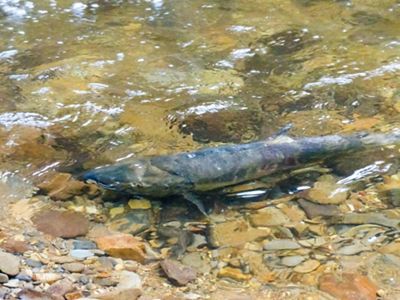
Investments from carbon credits are also helping fund studies and experiments to build TNC’s knowledge about the impacts of old-growth restoration and identify ways to increase carbon sequestration. Because this is a complex, emerging field and there is a great deal still to learn, Dr. Tanushree Biswas, TNC’s Carbon Program Director for the Emerald Edge, stresses that this pilot project is just the beginning:
“The climate is changing in real time, and what is happening on the ground in this project is going to provide evidence in real time,” says Biswas. “This is a new and evolving field and there is still a lot that we need to learn about the connections between improved forest management, carbon sequestration, biodiversity and community—and how carbon financing can be used to improve and build resilient forests and communities as we transition to a carbon-neutral future.”
That is exactly what TNC is aiming to achieve by working in partnership with the U.S. National Indian Carbon Coalition (NICC) to support potential new, high-quality forest carbon projects led by local Tribes. In a recent interview, NICC’s Program Director Bryan Van Stippen, a Member of the Oneida Nation of Wisconsin and a key partner for the Emerald Edge program, told TNC he believes that:
“Tribes can be leaders in this industry and can bring forward new, higher standards and protocols so that carbon projects deliver true additionality and bring a range of co-benefits to Indian Country in terms of soil, air, and water. Because we believe that by protecting and preserving—rather than extracting and exploiting—your natural resources, you're going to have a healthier ecological system on your Tribal lands and that will benefit the health of Tribal members.”
Quote: Bryan Van Stippen
Tribes can be leaders in this industry and can bring forward new, higher standards and protocols so that carbon projects deliver true additionality and bring co-benefits to Indian Country in terms of soil, air and water.

Investments from carbon credits help fund studies and experiments to build TNC’s knowledge about the impacts of old-growth restoration and identify ways to increase carbon sequestration. This is a complex, emerging field and there is a great deal still to learn.
The Emerald Edge Accelerator: Boosting Community-Driven Natural Climate Solutions
Today, with a worsening climate crisis and old-growth forests endangered globally, the need to prioritize Indigenous- and community-led natural climate solutions is greater than ever. To that end, in 2022 TNC launched the Emerald Edge Accelerator to massively scale up the collective impact of NCS through Indigenous and local community-driven conservation. The program combines TNC’s developing carbon sequestration science, policy, biodiversity and economic expertise with relationships built over 20 years with Indigenous peoples, local communities and other partners, including small-forest landowners and business owners.
The Accelerator will facilitate a robust database of high-impact NCS projects that support local economies and align with community priorities, values and aspirations. Part of this work involves creating a database of high-quality carbon data and overlaying it with social data to understand where projects could be developed that can deliver carbon storage as well as social benefit.


Quote: Eric Delvin
TNC and our partners aim to show the world that conservation can be done differently and is more lasting when it’s rooted in Indigenous and community priorities.
Eric Delvin underscores that TNC staff and partners are pursuing the best available science and technology as they develop systems to monitor, report and validate carbon additionality and permanence. And this includes convening with Indigenous Peoples and local communities, and with government and nonprofit partners, to review new data, understand community priorities, and identify NCS opportunities with the highest carbon storage potential that also support community goals.
In the coming years, the Emerald Edge Accelerator will identify specific opportunities to protect living carbon reserves that collectively conserve at least 10 million metric tons of CO2e mitigation across 40 million hectares. This approach, combined with targeted investments, innovative financing and favorable policy conditions, makes the Emerald Edge a global hub for Indigenous- and community-led natural climate solutions that can complement other carbon reduction strategies.
“TNC and our partners aim to show the world that conservation can be done differently and is more lasting when it’s rooted in Indigenous and community priorities,” says Delvin. “This approach has benefits across the board for the climate, the region’s biodiversity, and for community and cultural vibrancy.”
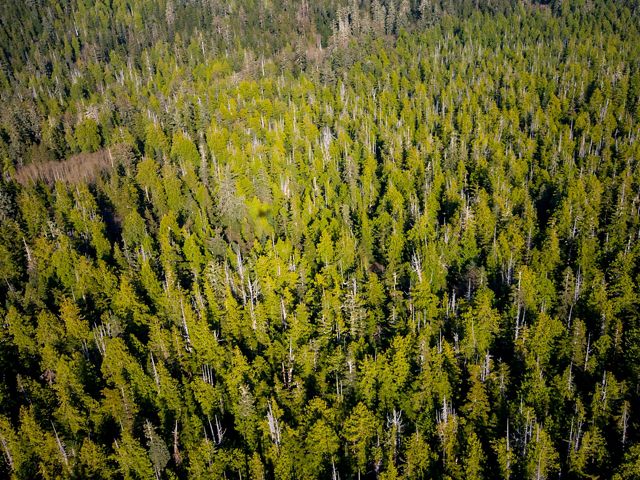
Living Carbon:
Stories of Nature's Climate Solutions
In this series, we showcase innovative carbon projects in Africa, northeastern Pennsylvania, Chile's Valdivian Forest, and the Emerald Edge along North America's Pacific coast.

